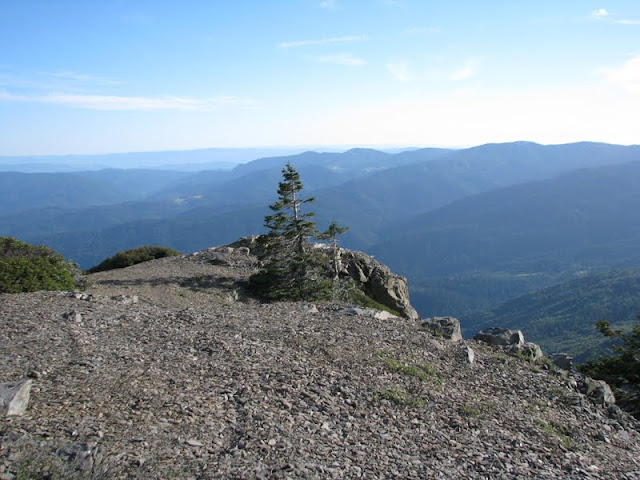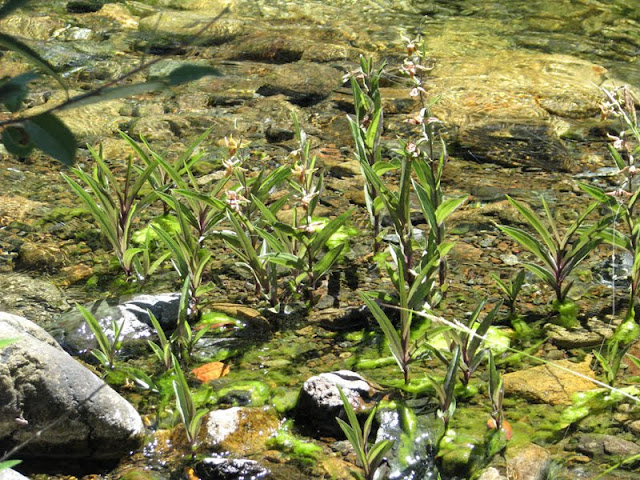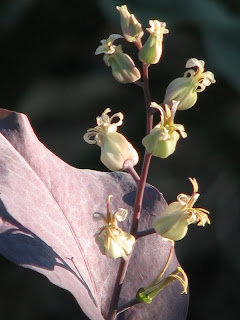My first solo trip into the "wilds" of California - at least beyond the immediate Bay Area counties - was to a mountain in the North Coast Ranges named Hull Mt. This was in 1981, and the destination had been suggested by the late Marshall Olbrich, original proprietor - with his partner Lester Hawkins, of Western Hills Nursery in Occidental in Sonoma Co. Marshall had been there a few years prior with Nevin Smith, another now-famous name in California horticulture, who is currently an owner of Suncrest Nursery in Watsonville, Santa Cruz Co. (Both Nevin and Marshall have way too many achievements in horticulture to go into here, but it was their trip to Hull that prompted my first adventure there.)
A view from about 6400' elevation on Boardman Ridge looking up toward the summit of Hull Mt., about 6,850'elev. A road cuts across to the upper left where it goes over a saddle; but on this weekend of 19 June 2010, it was stilled blocked by deep snow drifts.
Hull Mt. is located at 039degrees31'19.36"N and 122degrees 58'08.27"W. It is named for an early settler of Sacramento in the mid 19th century, James Hull. Hull had a hunting cabin on the mountain, but was found mauled to death, presumably by a grizzly bear. There is a site (place name) on the topographic sheet of this area named Hull's Grave, which I located back in 1981, marked by the rotting timbers of a large cross. Even today with our road system and macho vehicles it is a long tiring journey from Sacramento to Hull Mt.; it is hard to imagine the arduousness and perils of such a journey back in the 19th century.
Looking out to the SSW from the bluff at 6,400'; the small city of Ukiah in Mendocino Co. would be in the distant valley of the upper left section of the picture.
The view from the same bluff looking SE toward the rambling multiple summits of Snow Mt. (with snow). On the horizon ridge to the N of Snow Mt. is the conical silhouette of St. John Mt. and N of that Sheetiron Mt. To the S of Snow Mt. is Goat Mt. These are all some of the S-most peaks of the North Coast Range above 6,000 feet. The montane chaparral here is predominantly huckleberry oak, Quercus vaccinifolia and green-leaf manzanita, Arctostaphylos patula.
On the N side of the pass or saddle of Hull Mt. the snow banks were still 25' deep in some areas where winter snow drops heavily and shadows prevent melting until June or even July. The dense conifer woodland here is mostly red and white firs (Abies magnifica shastensis and A. concolor).
Although I had returned to Hull Mt. and environs several times in the 80's, it was always with other people, usually on long road trips where we passed through quickly with only brief stops to photograph or collect seed. Thus I had a yearning to go back and re-visit on a personal journey, maybe even re-discover some of that excitement of seeing it for the first time. In this regard, I was not disappointed. The road system was even more confusing than I remembered and the road was certainly in even worse state of disrepair than that first trip when I was sure I was going to ruin my car. Even with a 4WD truck today, I had the same thoughts on this journey. But, as usual, I made it up to near the summit before being stopped by snow, and, as usual, the best part of the trip began after getting out of the vehicle.
Although the presence of the snow meant hiking beyond my camp, it meant I was here at the perfect time to see the brief beauty of snow melt plants in flower. The first 'beauty" I came across was a plant I had first seen here at Hull in 1981, Fritillaria glauca, the talus fritillary. It was as beautiful as I remembered.
Talus fritillary, Fritillaria glauca, an exquisite member of the Lily Family, growing out of deep loose talus chips. The paired silver gray glaucous foliage - thus the "glauca" in the species name - is nearly identical to some tulip (genus Tulipa) species. If you were to turn the flower upward, the resemblance is ever more compelling.
The flower color of talus fritillary is mostly a bronzy purple-brown, or sometimes with more golden color on the inside giving an tawny-orange. There can be pure golden yellow flowers on some, though rare here, and none were seen on this trip.
Fritillaria glauca is restricted to Northern California and southern Oregon, though I have seen it almost exclusively in the North Coast Ranges (as opposed to the Klamath region). It is only 4 or 6" tall and is easy to overlook, but is almost always on the N side of a ridge or peak, in what are called "snow beds", those areas where snow lingers the longest. While some plants are solitary, most form small colonies, the largest colonies can be 12" across.
On some flowers the petals seem to flare back more than others, although it is possible that this feature is merely an older flower, it is hard to determine being there only such a brief moment in time. These sites tend to be extremely windy and it could simply be a flower blown open by the wind.
In the evening light the sun shines into the flowers giving them even more radiant beauty.
Another jewel of a plant is an annual in the Portulaca family (Portulacaceae) called Claytonia saxosa. Those in some parts of the country know the genus Claytonia as spring beauty; here in the West, we mostly know them as miner's lettuce (Claytonia perfoliata) or a variety of other short-lived annuals and perennials. Two common annuals in our part of CA, found mostly on rock faces, talus and ledges are Claytonia exigua and C. gypsophiloides, both which have sea-anemone-like foliage and tiny white, pink or pink-stenciled flowers. However both can occur in such numbers during late winter or early spring to be quite colorful and lovely, C. gypsophiloides being the showiest due to its larger and more numerous flowers and the brilliant satiny reflective quality of the inner petals.
Although I love seeing our low elevation species of Claytonia, there is something unexpectedly fresh and fun about C. saxosa. It also grows in masses on rock talus and rubble, a habitat seemingly inhospitable to a tiny annual, as the soil may be 4-8" below where the plant appears. If one moves the rocks aside, you see that while the ball of foliage and flowers appears on tops of the loose rocks, there is a thread of root that travels through the soil-less rock pieces until it hits real soil down below.
I first came across this in the evening when the flowers were closed for the day, but just the red ball of condensed foliage, bracts and buds was gorgeous. This plant is about 2" in diameter (5cm). The foliage initially is a greenish gray, but with the intense sun quickly turns red or pink, making these tiny annuals stand out from the barren rock slides.
Nestled in its bed of rock fragments, the plant seems to appear almost instantaneously after snow-melt, ready to flower and set seed almost immediately - the whole life cycle probably occurring in less than 3 weeks. Once in flower, the plant has a semi-succulence that permits it to ripen seed even if broken off of its roots.
Once morning comes, the pink/red ball of foliage becomes a ball of flowers. This area has been free of snow for about a week. (The other plants are the prostrate Lupinus albifrons v. collinus on the left and a single leaf of Fritillaria glauca on the right.)
The extensive gravel "pavements" of some of these montane ridges can have thousands of these tiny plants such as here at Windy Gap just N of Hull.
The expression, "Cute as a button" comes to mind often with this species.
The next species is a widespread spring perennial of many habitats, but when it grows at snow melt, it is yet another plant, quite unlike what I see regularly at low elevation. This species is Western buttercup, Ranunuculus occidentalis, in the Buttercup Family, Ranunculaceae. When I was first seeing this back in 1981, the high montane forms were given a varietal name, var. ultramontanus, which is no longer recognized (as distinct from the species), but which, given its unique gestalt, is at least a good label for this expression.
Just a few days, maybe only one, since the snow departed, and the flattened vegetation sprouts relatively large showy buttercup flowers well in advance of its foliage. The grass is Danthonia unispicata(?).
Close up of several flowers and the silky foliage just starting to expand from the ground. Eventually this will produce a stem over 1' tall and branched, much like the typical species. But at this stage it resembles some of the butercups that are totally restricted to snow beds, such as Ranunuculus eschscholtzii of the mountains of Western N America.
Part 2 will feature another fabulous Fritillaria.
And goodbye to our lovely Fritillaria glauca.




















































